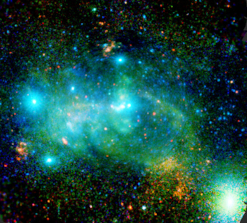HEAPOW: X-raying the Heart of Our Galaxy (2023 Mar 20)
Posted: Mon Mar 20, 2023 4:37 pm
 X-raying the Heart of Our Galaxy
X-raying the Heart of Our Galaxy
In many ways our knowledge of other galaxies is much better than that of our own home galaxy, the Milky Way. Embedded as we are within the Galaxy, surrounding by enormous clouds of obscuring dust, the shape of the Galaxy, its center, and our location within it were first teased out by painstaking observations of stars and star clusters. But a fuller understanding of the Milky Way requires the ability to peer through the dust which lines the disk of the Galaxy, especially toward the center of the Milky Way. X-rays are particularly good at penetrating dust, so studies of the Milky Way by X-ray observatories like the Einstein X-ray Observatory, ROSAT, Chandra, XMM-Newton and eROSITA have provided important information about the structure of the Milky Way. The image above shows a mosaic of X-ray images near the center of the Milky Way from the XMM-Newton X-ray observatory. XMM-Newton is a large X-ray telescope, and is particularly good at revealing faint sources and structures. The XMM-Newton mosaic reveals X-ray emission from binary stars containing normal stars coupled with X-ray emitting neutron stars or black holes, along with emission from star clusters, supernova remnants, and bubbles and superbubbles produced by winds and explosions of massive stars. The image is color-coded: red indicates low-energy X-rays, green medium energy X-rays, and blue the highest-energy X-rays that XMM-Newton can detect. The center of the Milky Way is embedded in the diffuse, bright region at the center of the image - the domain of the Milky Way's monster black hole, Sgr A*.
| << Previous HEAPOW | High Energy Astrophysics Picture of the Week | Next HEAPOW >> |